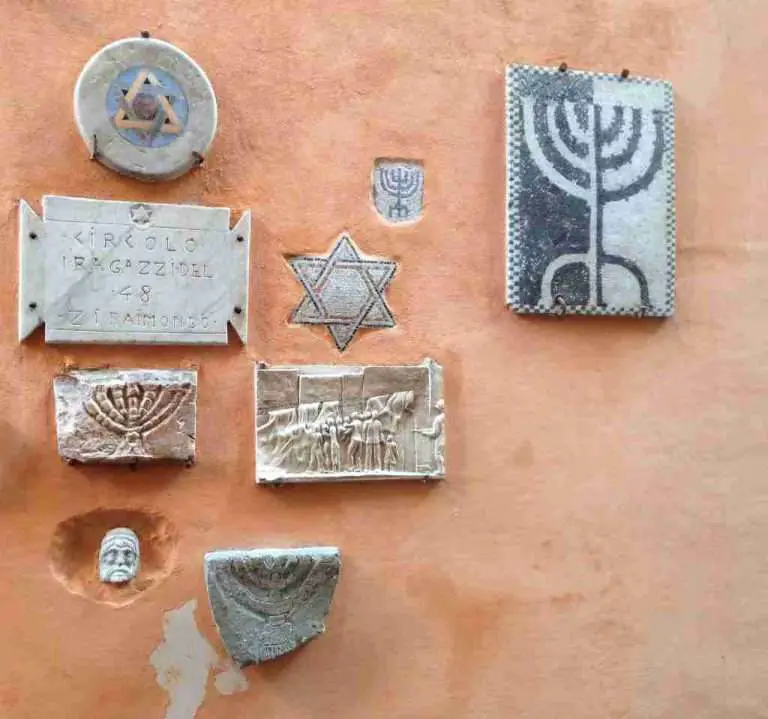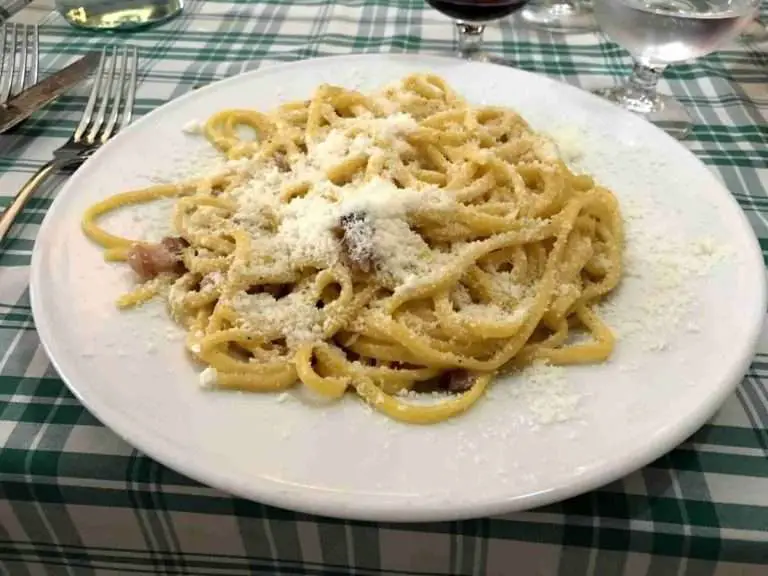
In 1499, Tuscan artist Luca Signorelli signed a contract to paint two remaining sections of the Cappella Nuova (new chapel) of the Duomo in the Umbrian town of Orvieto. By 1502 (or 1504, depending on which documentation you read), he had completed his “End of the World” fresco cycle in what is now known as the San Brizio Chapel.
The apocalyptic scenes, some “with their winged devils diving and rolling in the sky, and death-rays devastating terrified crowds on the ground below, uncannily prefigure 20th-century science fiction.” His dramatic, muscular human figures also look familiar. Signorelli, who was born in 1445, is seen as an influence on both Raphael and Michelangelo. Michelangelo’s “Last Judgment” in the Sistine Chapel seems to borrow some of the ideas and techniques from Signorelli’s fresco cycle.
I’ve long admired Orvieto’s cathedral, which sits on the top of its hill like a glimmering, gold-and-white mirage. Inside, the church is even more impressive, especially because of Signorelli’s fantastical frescoes. But the one story that I have always remembered and enjoyed with regards to Signorelli and what is considered his masterpiece is that he was partially paid in wine.
Described by Gabriele d’Annunzio as “the sun of Italy in a bottle,” the white wine of Orvieto, known as Orvieto Classico, has been known to people on this peninsula since Etruscan times. Papal courts have served this wine and there are at least two (and surely many more) instances in history when famous artists requested this highly prized wine as part of their payment. While PInturicchio’s working time in Orvieto was cut short purportedly because of “too much blue, too much gold, and too much wine,” the quick-brushed Signorelli, whose contract with Pope Urban IV stipulated that he be given as much Orvieto wine as he wanted (che gli si desse di quel vino orvietano quanto ne volesse), finished his commission before anyone could comment on just how insane some of his paintings were.
My Italy Roundtable colleague Rebecca wrote about Signorelli’s horror show a few years back. For this month’s Roundtable post on wine, I wanted to show that Signorelli, like Pinturicchio, was enjoying the local wine a little too much when he was working in Orvieto. Or maybe he got ahold of some bad mushrooms? Let’s have a look:

Signorelli began his fresco cycle with this scene about the Sermon and Deeds of the Antichrist (larger view). Most scholars consider this a commentary on the firebrand Dominican friar Savonarola, who had instilled the fear of God into Florentines for years until his egotistical doomsday prophesying led to his ex-communication in 1497 then execution in 1498.

Signorelli’s Antichrist gets advice from the Devil. Is that the Devil’s or the Antichrist’s hand that’s slipping under the folds of the pink cloak? Surely that trick of the eye was not an accident.

You can also see Signorelli’s self portrait on the left of this fresco panel. He’s the one looking at you.

As Signorelli progressed with his work, he got a little weirder. Are those lasers coming out of the eyes, mouths, and hands of the flying demons in this “Destruction of the World” panel? I can’t help but think Signorelli got a little lazy with his brush and thought, “Eh, I’m just going to let those red streaks stay.”

Where Signorelli turns humorous, macabre, and truly wacky is in his rendering of the “Resurrection,” where the old and newly dead rise out of their graves to be be judged.

What is going on here?!?!

Simon Abrahams, who runs the website Every Painter Paints Himself, writes at length (PDF) about the above fresco, The Punishment of the Damned, and how Signorelli inspired Michelangelo. His research convinced me even more that Signorelli was wrestling with some mental demons or often in a state of hyper reflection, perhaps a cause or result of his unlimited access to vino Orvietano. Abrahams writes:

This understanding of Hell, and of the whole cycle in the Capella Nuovo in Orvieto, helps explain why one of the demons in the center of The Punishment is a portrait of Signorelli himself (at left). The demonic self-portrait is inside his own mind. Antonio Paolucci has argued that the self portrait’s presence in Hell is a clear indication that the scene is more than just an illustration of a Biblical event. Furthermore, since our perception of other people can only be a composite of what we know about ourselves, so everyone we know is a reflection of us too. Thus all the characters in these imagined Hells, whether in Orvieto and the Sistine Chapel or in Dante’s Inferno, whether demon or damned, represent varying aspects of the author himself, his mental features personified. One scholar has claimed that these demons in Hell are the first in Western art to be given human bodies rather than the torsos of monsters and insects. Even if not strictly the first, the unusual humanity of these demons may have been intended to suggest to contemporaries that they were indeed looking at demons on the inside, not out.
-Simon Abrahams, Every Painter Paints Himself
Further, Abrahams goes on to explore Signorelli’s reverence towards Dante, who features not only in a panel on the lower part of the chapel’s wall but also hidden in profile within the “Damned” fresco. See Abrahams’s PDF supplement on this (page 2) .
Finally, please note that while I am not an art historian, I have long been mesmerized by Signorelli’s intoxicating, apocalyptic frescoes in the San Brizio Chapel and I have long wondered what could have moved him to interpret the end of the world and the Last Judgment with countless muscular nudes, lively skeletons, and seemingly out-of-context references to writers (Dante, Ovid) and Emperors (Sallust, Claudian).
Futher, the legend that Signorelli was paid in wine is an anecdote that has stuck in my head since the first time I saw and read about his Orvietan masterpiece. Whether Signorelli had a drinking problem is my own crazy theory. But the more I looked at his fresco cycle while writing this piece, the more I thought I was on to something.
You can see more about the San Brizio Chapel (the entirety of which I did not feature above) and its cathedral on the Orvieto Duomo website.
Read more posts about “wine” from the rest of the Italy Roundtable.
- Jessica – Wine Tasting in Italy
- Rebecca – The Art of Drinking: Il Carapace
- Alexandra – Brolio Castle: some wine with your history
- Kate – On weddings and (too much) wine
- Michelle – La Vendemmia in Calabria
Post first published on September 16, 2015






